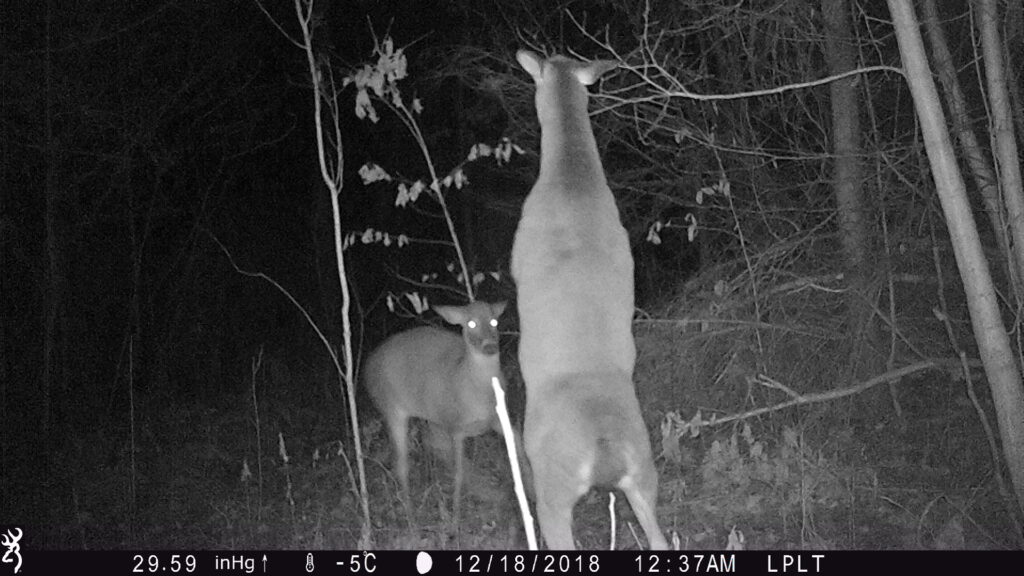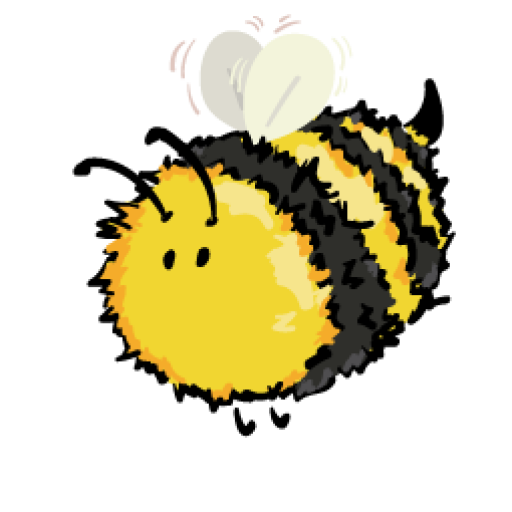
We have a standing rule in our house, and it’s that Neil can and should wake me up for animals. If the motion light comes on, or there is an unusual scurry across the roof. Neil goes to bed much later than I do, so if he hears a nighttime critter, I want him disturb my slumber. I can always get more sleep later, but a flying squirrel perched on the window is right now. And if it stars a flying squirrel, I’m happy to have a waking dream. (Unfortunately our cat Oliver also observes this rule, occasionally jumping into our bed with a mouse in his mouth at 3AM. I prefer the flying squirrel dreams. The Oliver ones drift a little closer to nightmare…)
The same “come and get me for critters” rule applies during the day too. If an excellent caterpillar like an Imperial is spotted in the yard. Or a porcupine shuffles through the woods. Or a ruffed grouse is tightrope walking the poplars. The wildlife here is both abundant and secretive, and I don’t want to miss the glimpses.
The rule applies to all critters. The “good” and the “bad” ones. Whether it’s an opossum triggering the motion light, a baby raccoon discovering the bird feeders (I must remember to bring those feeders in at night…), or a possible sighting of a saw whet by the chicken coop. I want to see them all.
The line of good and bad animals is drawn in different places for different people. Those who have lost chickens to fox may have more trouble seeing a canid’s russet beauty. You’re probably not delighted to encounter a milk snake if you have a fear of things that slither. A bad childhood experience with a domestic dog could easily leave a person wary of coyotes.
And then there are the cultural baggage, biases, and bruises we carry of “good” and “bad”. Painted turtles good, snapping turtles bad. Dangerous animals and tame animals. Clean animals and dirty animals… Cute animals and ugly ones. Even “predator” and “prey”. But the more critters I encounter and observe, the more I learn about them, the less these divisions hold meaning for me.
I structured so much of my understanding of the world around models that aren’t just out of date, not just expired, but were never true. Bears growl, bunnies are sweet, the tiny are afraid of the large. “Not so”, nature keeps gently reminding me here, “not so”.
Take the alpha wolf. Dr. L. David Mech, the scientist who popularized the concept of “alpha male” wolves in his 1970 book “The Wolf”, has devoted a sizable part of the rest of his career trying to explain he was wrong, and requesting, unsuccessfully, that the publisher stop publishing his earlier work:
The concept of the alpha wolf is well ingrained in the popular wolf literature, at least partly because of my book “The Wolf: Ecology and Behavior of an Endangered Species,” … Although most of the book’s info is still accurate, much is outdated. We have learned more about wolves in the last 40 years than in all of previous history.
One of the outdated pieces of information is the concept of the alpha wolf. “Alpha” implies competing with others and becoming top dog by winning a contest or battle. However, most wolves who lead packs achieved their position simply by mating and producing pups, which then became their pack. In other words they are merely breeders, or parents, and that’s all we call them today…”
~Dr. L. David Mech
As for growling bears, ask someone who works with bears and they will tell you that bears hardly ever growl. It’s just not how and when they vocalize.
As Mike McIntosh who runs the bear rehabilitation centre Bear With Us put it (here): “They don’t make a lot of sounds that we often hear and think they make. Bears are usually only vocal when they’re either afraid or in pain. Most of the time they’re quiet”. The cartoon version, it’s not just a caricature, it’s a lie.
Like the lemmings who were dumped over the cliff in the fake
“documentary” that shaped so many of our understanding of those rodents — it was not, is not, and never was true. Sweet little rabbits will fight each other, as will docile does. Father birds will sit on eggs, mothers will build nests. We either just didn’t look, or didn’t see.
Similarly, the tiny are not always intimidated by the large, and prey don’t always give ground to predator. One spring evening we were having dinner when the character of the birdsong out the window suddenly changed, like someone had abruptly clicked to the next song, mid-track. I looked out the window and saw a feathered kerfuffle unfolding in the large maple tree in our yard. A sizeable hawk was perched on a branch, but not for long. It was being pelted at all angles by tiny birds. A variety of tiny birds. Nearby small nesting moms and pops and various bystanders were having none of this large bird in their midst. Now that we’re aware of it, we’ve seen this “mobbing” behaviour many times since.
It is not uncommon to see a group of blackbirds or swallows chasing a hawk or eagle, or a group of songbirds fluttering and calling around a perched owl.
Such “mobbing” behavior is probably the most frequently observed overt anti-predator strategy. Nevertheless, the exact purpose of such noisy group demonstrations remains a matter of some debate.
…one function of mobbing may be educational–to teach young birds… Another may be to alert other birds to the presence of the predator, either getting them to join in the mobbing or protecting them, since a predator is unlikely to be able to sneak up on an alert victim.
Much is lacking in our understanding of mobbing. It is not clear why predators don’t simply turn on their tormentors and snatch up one or two of the mobbing birds. If they did, presumably mobbing would quickly disappear; that it persists suggests that surprise is an essential element in raptor hunting.
~The Birder’s Handbook by Paul R. Ehrlich, David S. Dobkin, and Darryl
Wheye
But this isn’t about a victory of tiny birds over the big mean hawk either. David and Goliath stories stir the soul, but no one is the villain in their own story, and the tale is of course different from Goliath’s perspective. A “predator” has its own beautiful babies to feed. Its own soaring life to support. Life-Death-Life, around and around we go. The fierce and the delicate, wrapped up in one package.
I met my wise and wonderful friend Tess Miller when I was a volunteer at Sandy Pines Wildlife Centre, where she was a member of staff. She’s cared for a wider variety of animals than most of us will encounter at a distance, in a lifetime. While we were mucking out enclosures and hand-feeding critters, Tess shared a lot of insights into animal behaviour. As she put it: “Once you have the chance to work with or observe any animal, you will grow a strong admiration and appreciation for its abilities to survive, regardless of what those abilities are.”
I have a theory that so many of these good/bad, cute/ugly divisions come from a discomfort with our own complexity. Our own times of growling, or being dirty or disheveled or annoying. That we think creatures have to be cute to be loved, or “alphas” to be worthy, because of our own deep-seated fears. When we can’t completely accept our own shades of grey, we pedestal some animals as ideal, and pretend they are something they’re not. In doing so, missing the beauty of their — and our — complexity. How beautiful the “ugly” animals are, and how gentle the giant beasts. The shining texture of a snake, an earwig mother doting on her babies, two does striking at each other with their sharp hooves.
“It’s not by accident that the pristine wilderness of our planet disappears as the understanding of our own inner wild nature fades.”
~Clarissa Pinkola Estes
A world without good and bad guys, with no alphas, no roaring bears or ever-sweet bunnies is a more confusing and beautiful place to be. Up is down, down is up and sweeping statements just sweep away the truth. When the truth, it turns out, is so much stranger than fiction. So much more interesting. So much more beautiful and compelling and frightening. So much more… hopeful.
~Kate
A version of this article also appeared in the OWA‘s The Ontario Woodlander.
